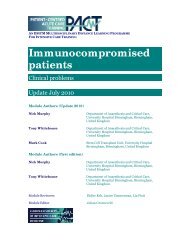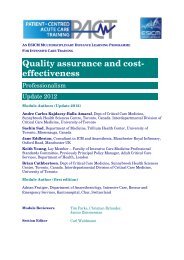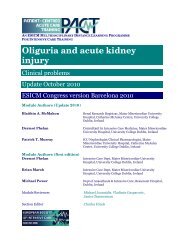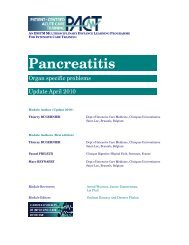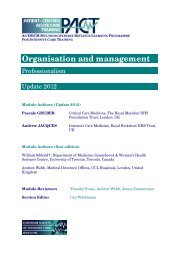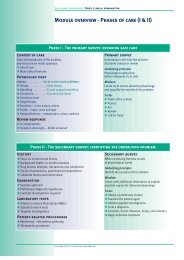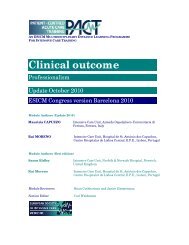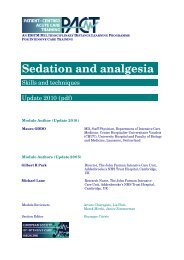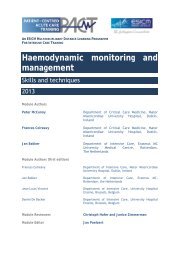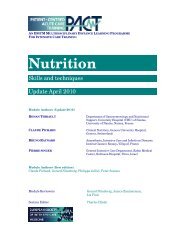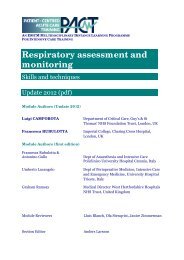Pyrexia - PACT - ESICM
Pyrexia - PACT - ESICM
Pyrexia - PACT - ESICM
You also want an ePaper? Increase the reach of your titles
YUMPU automatically turns print PDFs into web optimized ePapers that Google loves.
Task 1. Assessing and measuring fever in ICU<br />
Blood should be obtained percutaneously via venipuncture (or via ‘clean-stick’,<br />
newly introduced arterial or central venous catheters), and 10 ml placed in each<br />
of two bottles for aerobic/anaerobic cultures. At least two to three sets, 10 min<br />
apart, should be taken, after proper skin preparation.<br />
Shafazand S, Weinacker AB. Blood cultures in the critical care unit: improving<br />
utilization and yield. Chest 2002; 122(5): 1727-1736. PMID 12426278<br />
Microbiology<br />
The commonly identified micro-organisms causing infections in<br />
the ICU include Gram-negative bacilli (mainly<br />
Enterobacteriaceae, Klebsiella, Pseudomonas, Acinetobacter<br />
and Serratia spp.), Gram-positive bacteria such as coagulasenegative<br />
staphylococci and S. aureus and Candida albicans.<br />
Organisms should<br />
always be<br />
considered in the<br />
specific clinical<br />
context when<br />
making ‘best guess’<br />
therapeutic<br />
decisions<br />
Blood culture results with S. epidermidis are considered clinically ‘significant’, if<br />
present in more than one bottle and are rapidly growing in culture. Candida<br />
spp. may cause catheter-related blood stream infections, wound infections, and<br />
peritonitis. Culture of Candida spp. may, of course, represent colonisation as<br />
opposed to infection, but there are no commonly accepted criteria to separate<br />
these conditions. Candiduria exceeding 10 5 colony forming units/mL in two<br />
urine specimens taken before and after change of a bladder catheter in a patient<br />
with clinical signs of sepsis may point to Candida as the aetiology. A high<br />
Candida colony count in urine, recovery from two or more otherwise sterile sites<br />
(excluding urine and sputum) may point to Candida sepsis in the febrile ICU<br />
patient with leukocytosis (>12.0 x 10 9 /L). Candidaemia (e.g. after change of<br />
intravascular catheters) is indicative of infection. Candida endophthalmitis,<br />
oesophagitis, suppurative thrombophlebitis or wound infections/peritonitis<br />
(‘open abdomen’) may be the source of deep Candida infections. Further<br />
relevant details are to be found in the following reference.<br />
Holley A, Dulhunty J, Blot S, Lipman J, Lobo S, Dancer C, et al. Temporal trends,<br />
risk factors and outcomes in albicans and non-albicans candidaemia: an<br />
international epidemiological study in four multidisciplinary intensive<br />
care units. Int J Antimicrob Agents 2009; 33(6): 554. e1-7. Epub 2009 Jan<br />
22. PMID 19167196<br />
Viral infections causing pneumonia, even in critically ill, immunocompromised<br />
(or immunocompetent) patients, are rare. Herpes virus, cytomegalo, adeno- or<br />
respiratory syncytial viruses or Chlamydia spp. are considered the most<br />
frequent causes.<br />
[10]




